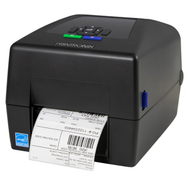How RFID Product Labels Enhance Inventory Management?
11th Aug 2025
TL;DRRFID product labels utilise radio frequency technology to track inventory in real-time, eliminating the need for direct line-of-sight, making them faster and more accurate than traditional barcodes. Unlike barcodes, RFID labels can store more data, scan multiple items simultaneously, and operate reliably in harsh conditions, although they come with a higher upfront cost. There are various types of RFID labels, including passive (no battery), active (battery-powered), semi-passive (battery-assisted), and speciality tags for specific surfaces and environments. Key benefits of RFID labels include real-time visibility, reduced human error, faster audits, better supply chain efficiency, and improved data accuracy. Challenges in RFID integration involve system compatibility, initial investment, environmental interference, staff training, and maintaining data consistency and security. To ensure success, businesses should follow best practices, including thorough planning, selecting the right hardware, conducting pilot tests, training staff, and continuously monitoring performance. Top RFID printers, such as the Printronix T820, Zebra ZT411R, SATO CL4NX Plus, and Toshiba BX410T, offer high-speed, high-resolution printing and RFID encoding, making them suitable for retail, logistics, and manufacturing applications. |
|---|
Inventory management has evolved significantly from manual stock counts and the use of barcode scanners. Today, RFID product labels are helping businesses take control with faster, more accurate tracking. By using radio waves to identify and track items in real-time, RFID eliminates the need for line-of-sight scanning and drastically reduces human error.
These smart labels allow products to be located, tracked, and updated automatically within a system, whether they’re on a shelf, in a warehouse, or in transit. The result? Quicker stock checks, fewer discrepancies, and better decision-making based on live data.
Here’s a closer look at how RFID product labels are reshaping inventory management and driving smarter, more efficient operations.
Understanding RFID Product Labels
RFID product labels, also known as radio frequency identification, use radio waves to automatically identify and track items, offering a faster and more accurate alternative to traditional tracking methods. Each label contains an RFID chip and antenna that communicate wirelessly with RFID readers, enabling real-time inventory updates with minimal human intervention.
How RFID Labels Differ from Traditional Barcodes?
While barcodes have long been the standard for product tracking, RFID product labels offer significant upgrades in speed, efficiency, and accuracy. Let’s take a closer look at how the two technologies compare in terms of reading range, data handling, and overall performance in inventory control.
|
Feature |
RFID Product Labels |
Traditional Barcodes |
|---|---|---|
|
Technology |
Radio frequency (RF) |
Optical (laser/light) |
|
Data Capture |
Wireless, no line-of-sight needed |
Requires direct line-of-sight |
|
Read Range |
Several feet (varies by type) |
A few inches |
|
Data Storage |
Can store and update more data |
Limited to static, printed information |
|
Simultaneous Reading |
Can read multiple labels at once |
One barcode at a time |
|
Durability |
Resistant to dirt, moisture, and rough handling |
Can be damaged by scratches or dirt |
|
Cost |
Higher initial setup and tag cost |
Lower cost, widely adopted |
What are the Types of RFID Product Labels Used in Inventory Management?
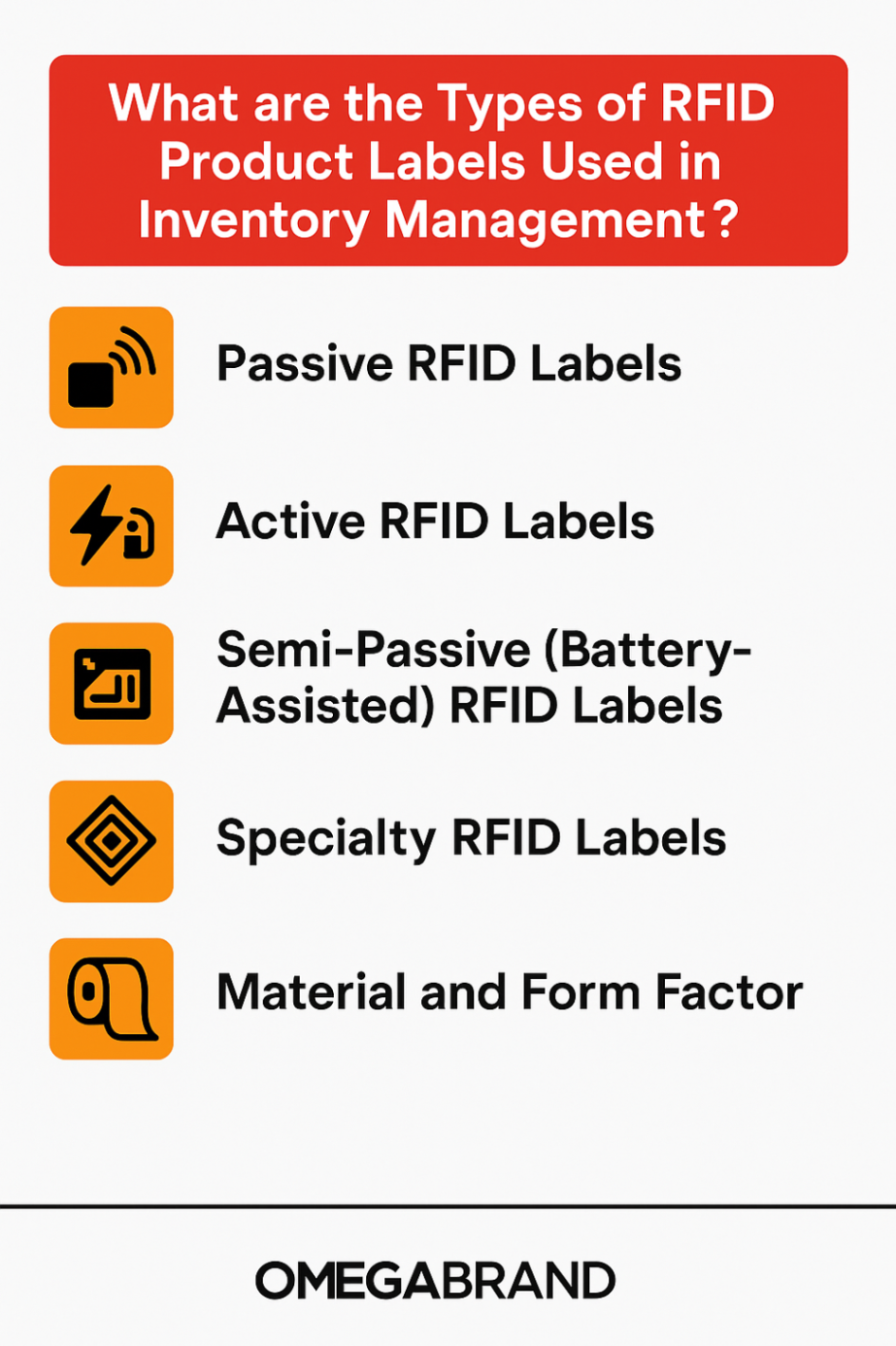
RFID product labels come in various forms, each suited to specific inventory management needs:
-
Passive RFID Labels:
-
No internal power source; activated by the reader’s signal.
-
Most common in inventory management due to their low cost and thin, flexible design.
-
Used for tracking retail items, cases, pallets, and assets in warehouses.
-
-
Active RFID Labels:
-
It contains a battery, enabling longer read ranges and continuous broadcasting.
-
Used for tracking high-value assets or items that move over large areas, such as vehicles or containers.
-
-
Semi-Passive (Battery-Assisted) RFID Labels:
-
It has a battery to power the chip, but relies on the reader for communication.
-
Offer improved read reliability in challenging environments.
-
-
Specialty RFID Labels:
-
Designed for specific applications, such as:
-
Metal-mount labels for tracking items on metal surfaces.
-
Heat-sealed or laundry tags for textiles and garments.
-
Cable tags for tracking wires and cables.
-
Rugged or ceramic tags for harsh industrial environments.
-
-
-
Material and Form Factor:
-
Labels can be made from paper, plastic, polymer, or even fabric, depending on durability and use case.
-
Substrates like PET and PVC are common for their flexibility and strength
-
What are the Key Benefits of RFID Product Labels for Inventory Control?
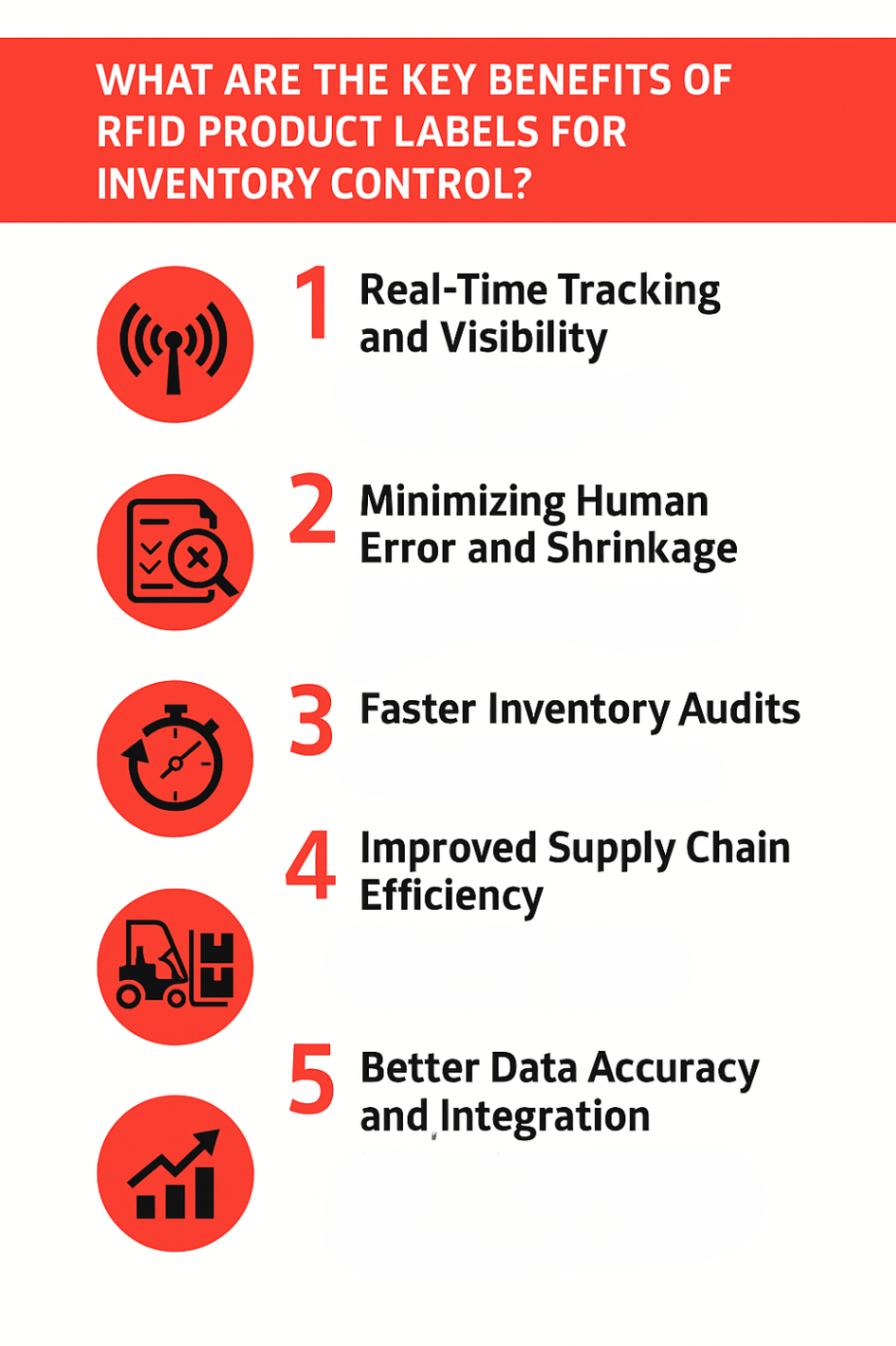
RFID product labels provide a range of benefits that help reduce waste, increase accuracy, and streamline supply chain processes. Below are some of the key advantages RFID brings to inventory control.
1. Real-Time Tracking and Visibility
One of the most valuable features of RFID product labels is the ability to track items in real time. Unlike barcodes, which must be scanned individually, RFID tags transmit data automatically when they come within range of a reader. This provides inventory managers with instant visibility into the location of products—whether they’re in storage, in transit, or on the shelf.
With this level of visibility, businesses can quickly locate specific items, monitor stock as it moves through the supply chain, and respond more quickly to changes in demand or unexpected disruptions.
2. Minimizing Human Error and Shrinkage
Manual data entry and traditional barcode systems leave room for mistakes—miscounts, duplicate scans, or failed scans can all lead to inventory inaccuracies. RFID product labels greatly reduce this risk by automating the tracking process. Since the reading is wireless and doesn’t require a direct line of sight, multiple items can be scanned at once with minimal human input.
This not only improves data accuracy but also reduces inventory shrinkage caused by human oversight, loss, or theft. With real-time recordkeeping and automated alerts, missing items can be quickly identified and addressed.
3. Faster Inventory Audits
Doing a full inventory audit with barcodes can take hours—or even days—depending on the size of the facility. RFID product labels drastically simplify and accelerate this process, as readers can scan hundreds of tags simultaneously and from several feet away. Audits that once required a full team and extended downtime can now be completed in a fraction of the time.
Faster cycle counts mean you can perform audits more frequently without disrupting daily operations. This results in more accurate stock levels and improved inventory planning.
4. Improved Supply Chain Efficiency
RFID product labels offer end-to-end visibility across the entire supply chain, from the point of manufacture to the retail shelf. With real-time tracking and data sharing, businesses can optimize procurement, monitor transit conditions, and reduce bottlenecks in distribution.
RFID also facilitates automation at various checkpoints, including receiving, sorting, and shipping, which can all be streamlined through RFID-enabled workflows. As a result, supply chain delays are minimized, and order fulfillment becomes faster and more reliable.
5. Better Data Accuracy and Integration
RFID labels not only capture product location but can also store additional data, such as batch number, expiry date, or destination. This rich data can sync automatically with back-end inventory management systems (WMS/ERP), enabling smarter analytics and real-time decision-making.
Because RFID product labels integrate seamlessly with warehouse and business software, inventory data remains accurate, up-to-date, and actionable. This level of integration supports better forecasting, reduced overstock, and improved customer service.
Integrating RFID Labels into Existing Inventory Systems
Integrating RFID product labels into your existing inventory setup can significantly enhance how you track, manage, and optimize stock. However, successful integration requires careful planning, technical know-how, and a clear understanding of both the challenges and best practices involved.
What Are the Key Challenges in Implementing RFID Inventory Systems?
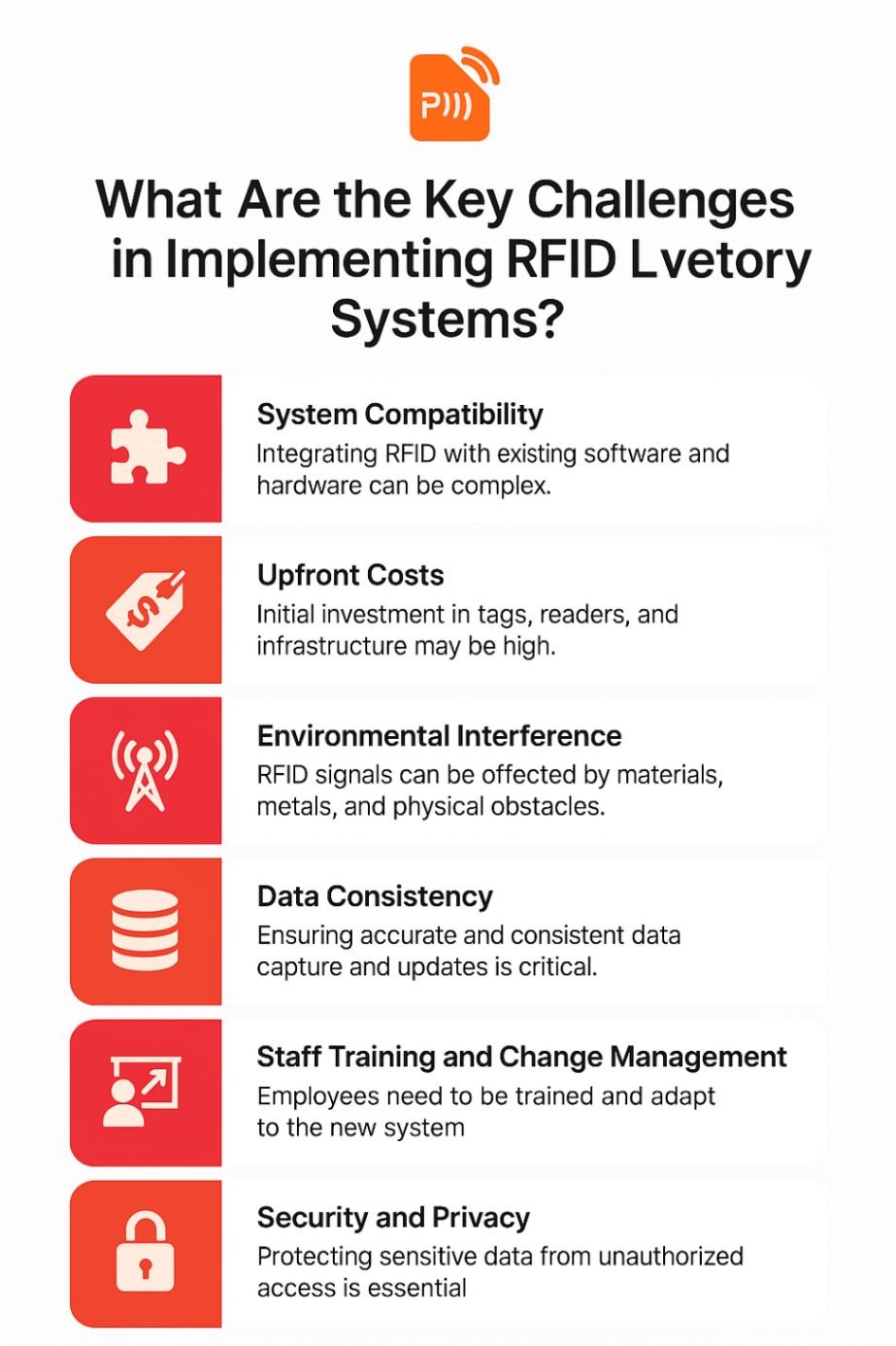
Integrating RFID with existing inventory systems isn’t always straightforward. Here are some of the most common hurdles businesses face:
-
System Compatibility: Many organizations use legacy inventory management software that may not natively support RFID data. Bridging the gap often requires middleware or custom integration to ensure seamless data flow between RFID readers and your inventory database.
-
Upfront Costs: The initial investment in RFID tags, readers, antennas, and integration services can be substantial, particularly for large-scale operations. While passive tags are affordable, active tags and infrastructure can drive up costs.
-
Environmental Interference: Metal surfaces, liquids, and dense materials can interfere with radio signals, resulting in missed readings or inaccurate data. Specialized tags and careful placement are often needed to overcome these issues.
-
Data Consistency: Ensuring that RFID-generated data is accurately and consistently updated across all integrated systems (ERP, WMS, POS) is critical. Data mismatches can lead to inventory discrepancies and operational headaches.
-
Staff Training and Change Management: Employees must adapt to new workflows and technology. Resistance to change or a lack of training can undermine the benefits of RFID integration.
-
Security and Privacy: RFID tags can be vulnerable to cloning or unauthorized reads if not properly secured. Implementing encryption and access controls is essential for protecting sensitive inventory data.
What Are the Best Practices for Successful RFID Integration in Inventory Management?
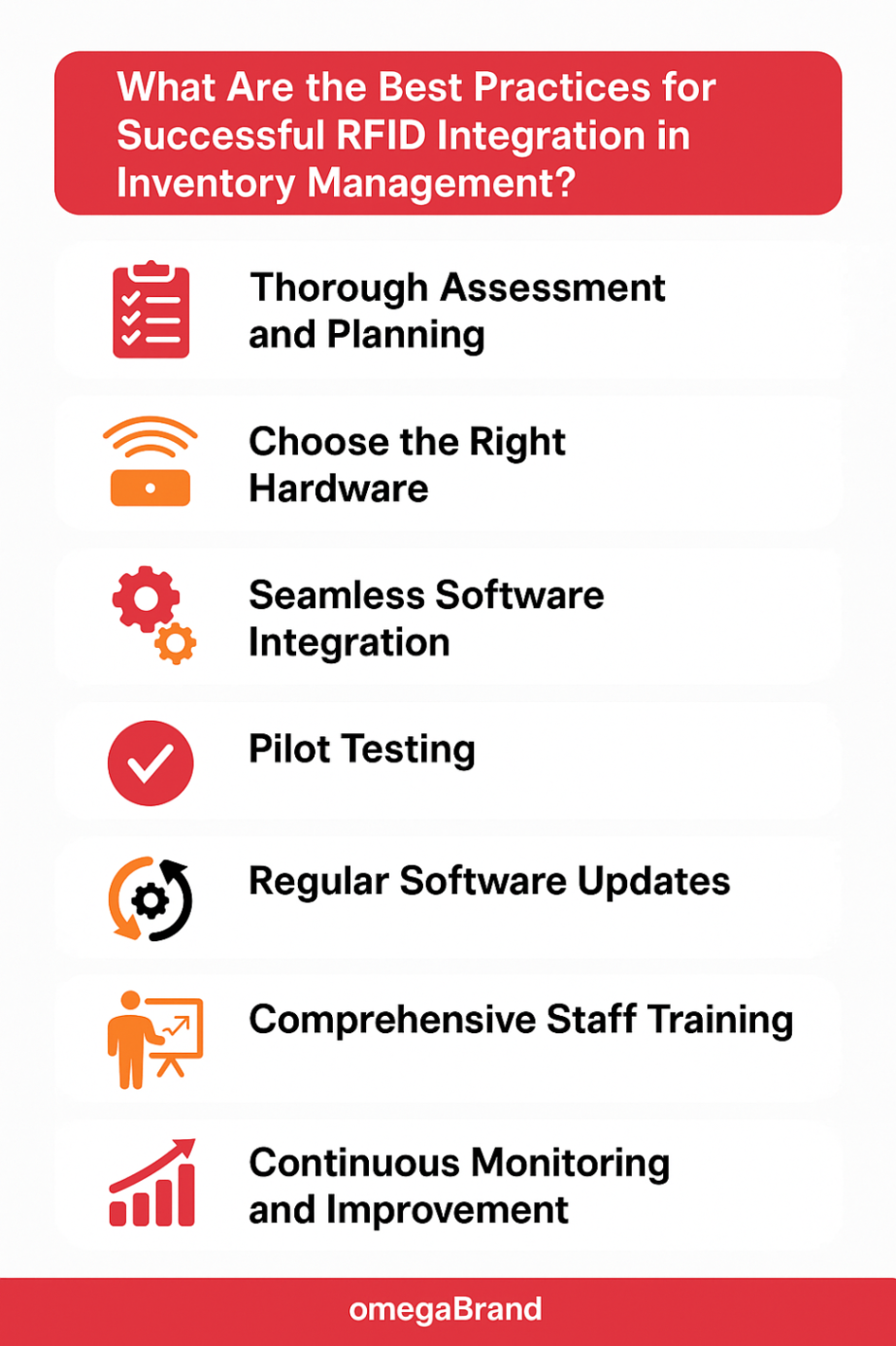
To maximize the benefits of RFID product labels and minimize disruption, consider these proven strategies:
-
Thorough Assessment and Planning: Start by evaluating your current inventory processes and defining clear objectives for RFID integration. Identify which products, locations, and workflows will benefit most from RFID.
-
Choose the Right Hardware: Select RFID tags and readers that match your operational environment. For example, use rugged or metal-mount tags in harsh or metallic settings, and ensure readers are positioned for optimal coverage.
-
Seamless Software Integration: Use middleware or integration platforms to connect RFID data with your existing inventory management systems. This ensures real-time updates and accurate analytics across all platforms.
-
Pilot Testing: Conduct a pilot program in a controlled environment before implementing it on a full scale. This helps identify technical issues, optimize tag placement, and fine-tune system settings without disrupting daily operations.
-
Regular Software Updates: Keep RFID firmware and middleware up to date to benefit from improved algorithms, security patches, and new features. Schedule regular maintenance to ensure system reliability.
-
Comprehensive Staff Training: Provide hands-on training for all employees involved in inventory processes. Clear SOPs and ongoing micro-learning sessions help maintain efficiency and data accuracy.
-
Continuous Monitoring and Improvement: After rollout, monitor system performance, gather feedback, and make adjustments as needed. Utilize analytics to pinpoint bottlenecks and refine inventory workflows for further optimization.
Top RFID Printers for Creating Smart Product Labels
Choosing the right RFID printer is crucial for producing reliable, high-quality smart product labels that support efficient inventory management and supply chain operations. Below is a detailed overview of leading RFID printers, highlighting their technical features, ideal use cases, and what distinguishes each model.
1. Printronix T820 UHF RFID 4-Inch 203 dpi 8 ips Desktop Thermal Label Printer w USB/LAN | T82R-100-1

The Printronix T820 is a compact desktop RFID printer designed for businesses that need reliable, high-volume label printing and encoding. Its robust build and versatile connectivity make it a strong choice for logistics, retail, and warehouse environments.
Key Features:
-
203 dpi thermal transfer printing for clear barcodes and text
-
8 inches per second print speed
-
4-inch print width
-
UHF RFID encoding (EPC Gen 2)
-
USB, Ethernet, Serial, and Real-Time Clock (RTC) connectivity
-
128MB DDR RAM and 128MB Flash storage
-
Supports over 1,000 labels per day
Pros:
-
Compact size fits easily on desktops
-
Multiple connectivity options for easy integration
-
High-capacity ribbon support reduces downtime
-
Reliable performance for continuous operation
Cons:
-
Lower print resolution compared to some industrial models
-
RFID encoding must be factory-installed and cannot be added later
-
Not ideal for extremely high-volume or harsh industrial environments
2. Zebra ZT411R 4" Wide 203 dpi, 14 ips UHF RFID Thermal Transfer Label Printer
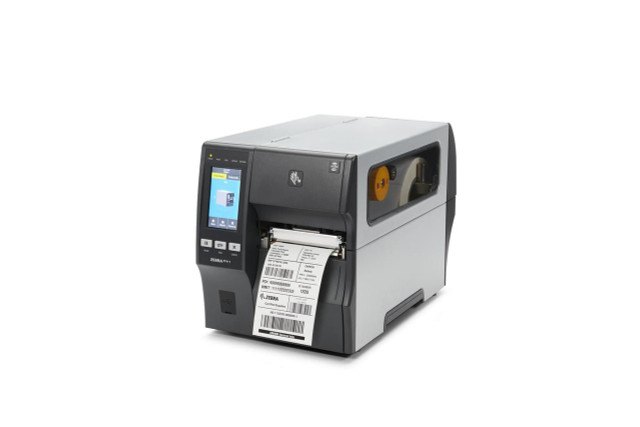
The Zebra ZT411R is a high-speed industrial RFID printer built for demanding environments. Its advanced connectivity and user-friendly design make it suitable for large-scale operations that require fast and flexible production of the perfect RFID label.
Key Features:
-
203 dpi thermal transfer printing
-
14 inches per second print speed
-
4-inch print width
-
UHF RFID encoder (factory or field installable)
-
Ethernet, USB, USB Host, Bluetooth 4.1, and optional Wi-Fi
-
Side-loading supplies path with color-coded and lighted media guides
Pros:
-
Exceptional print speed for high-throughput environments
-
Flexible connectivity, including wireless options
-
Intuitive media loading reduces user errors
-
Supports a wide range of label formats and media types
Cons:
-
A larger footprint may not suit small workspaces
-
Higher initial investment
-
Advanced features may require additional training for new users
3. SATO CL4NX Plus + 4"-Wide 203 dpi HF RFID & RTC Thermal Transfer Industrial Printer | WWCLP1801-NAR
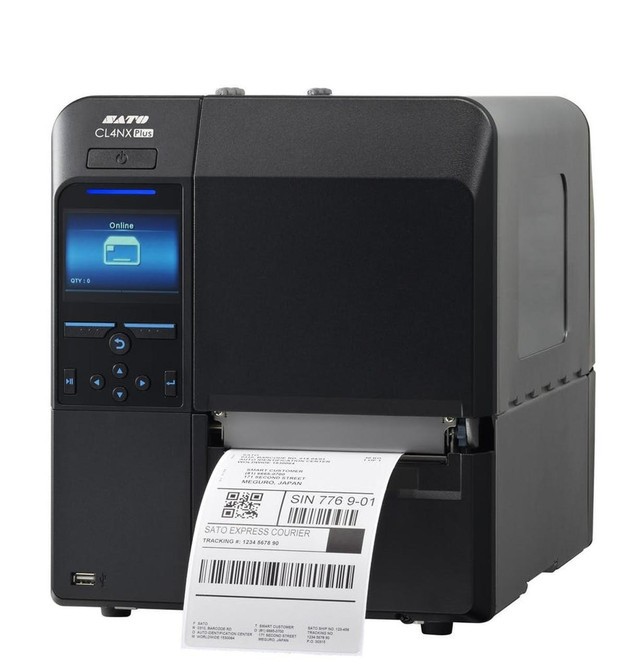
The SATO CL4NX Plus is engineered for industrial applications that demand both high-frequency RFID encoding and high-speed, reliable printing. Its rugged construction and advanced features make it a favorite for manufacturing and logistics.
Key Features:
-
203 dpi thermal transfer printing
-
14 inches per second print speed
-
4-inch print width
-
HF RFID encoding and Real-Time Clock (RTC)
-
Built for continuous, industrial use
Pros:
-
High-speed printing for large batch jobs
-
Durable design for harsh environments
-
Supports HF RFID for specialized applications
-
Reliable performance in demanding settings
Cons:
-
HF RFID may not be compatible with all supply chain requirements (UHF is more common)
-
Industrial design may be excessive for small-scale needs
-
Higher price point
4. Printronix T6304e 4" 300 dpi RFID Thermal Transfer Label Printer with USB/LAN
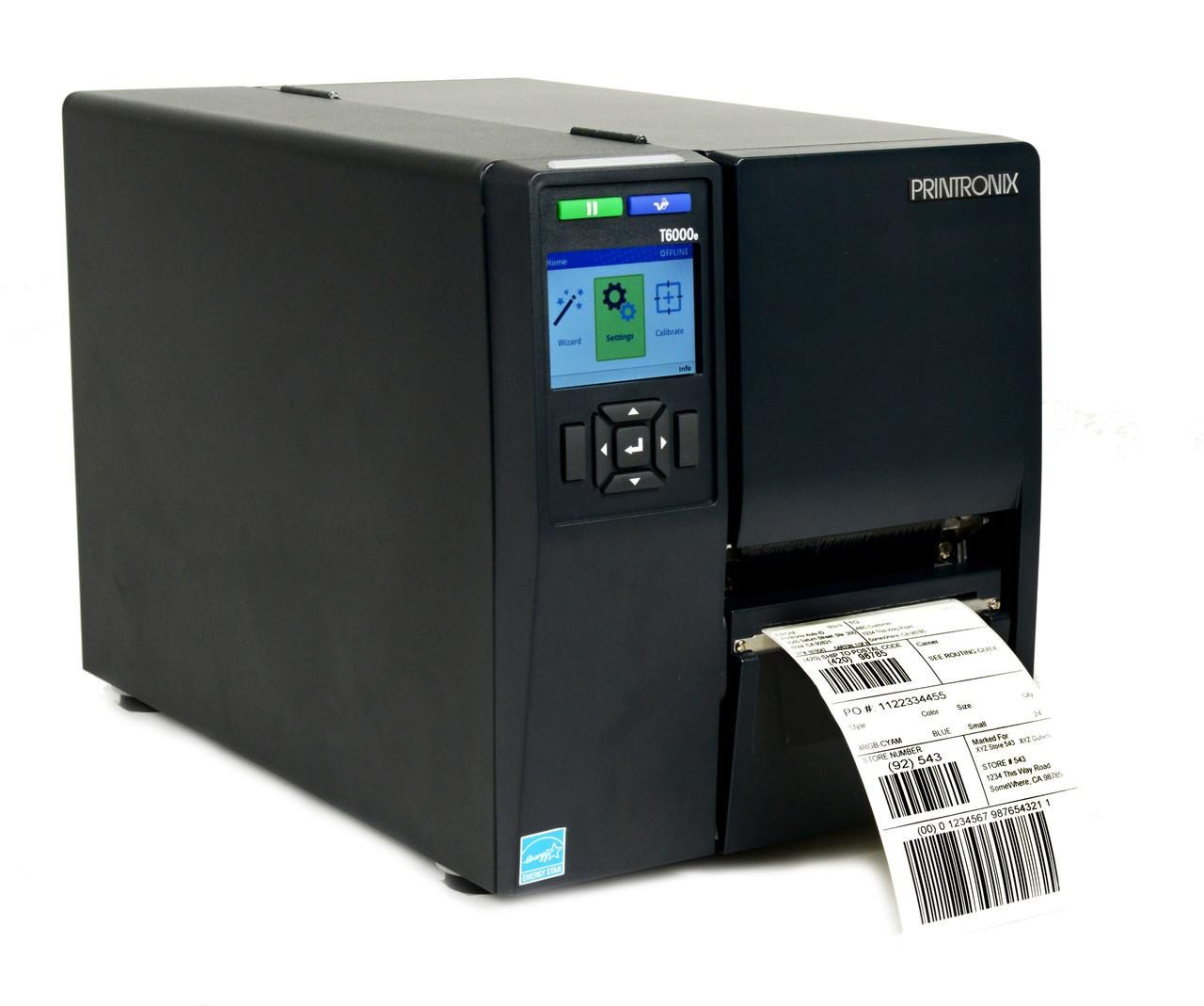
The Printronix T6304e is a high-resolution industrial RFID printer designed for mission-critical labeling. Its 300 dpi output is ideal for detailed graphics and small barcodes, making it suitable for compliance and asset tracking.
Key Features:
-
300 dpi thermal transfer printing for crisp, detailed labels
-
12 inches per second print speed
-
4-inch print width
-
UHF EPC Gen 2 RFID encoding
-
USB 2.0 and 10/100 Ethernet connectivity
-
Heavy-duty construction for 24/7 operation
-
Supports Walmart-compliant RFID labels
Pros:
-
High-resolution printing for detailed applications
-
Built for continuous, industrial use
-
Compatible with a wide range of RFID labels
-
Flexible media handling options
Cons:
-
Larger and heavier than desktop models
-
Higher upfront cost
-
It may be overkill for low-volume or basic labeling needs
5. Toshiba Tec BX410T 4", 305dpi, 14 ips Near Edge Thermal Transfer Label Printer with USB/LAN + RFID
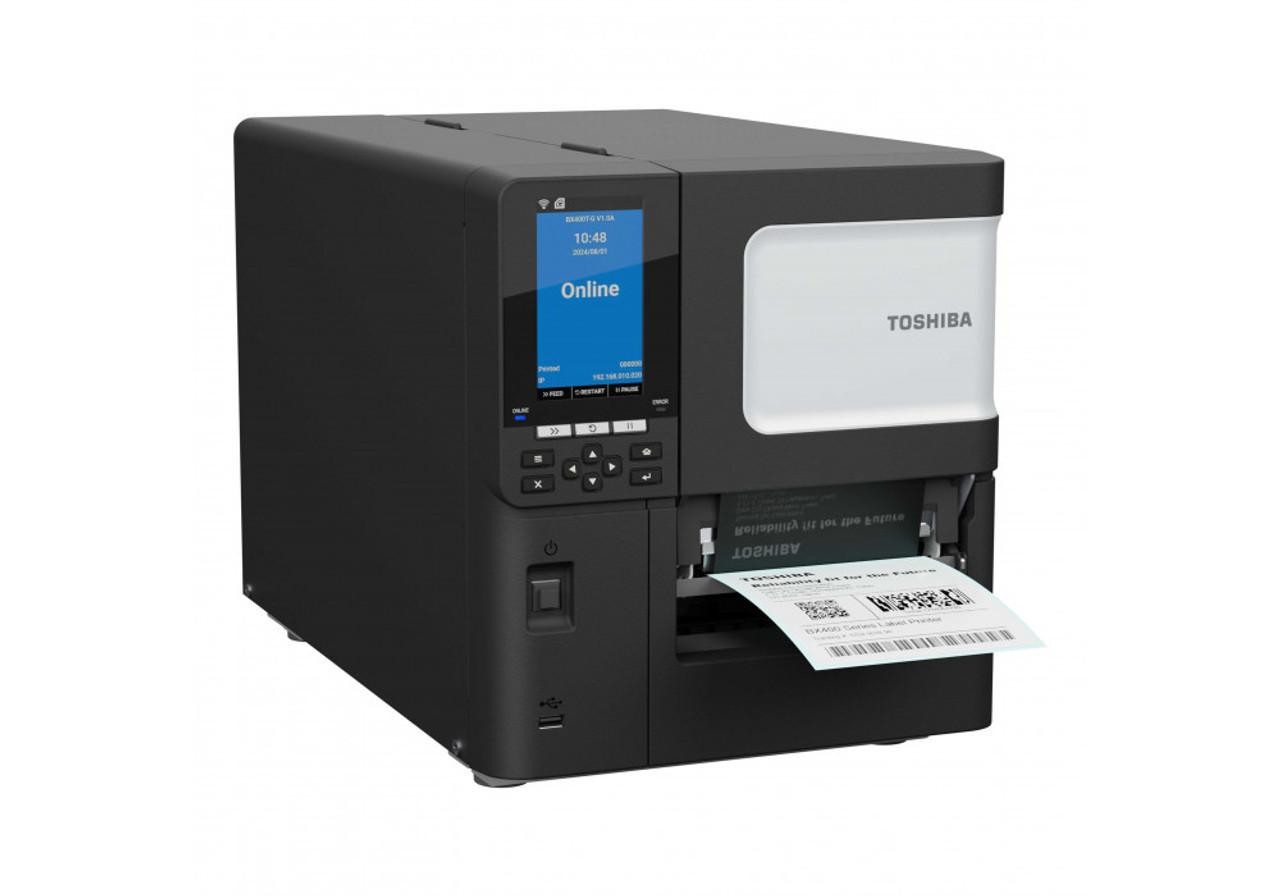
The Toshiba Tec BX410T combines near-edge thermal transfer technology with integrated RFID encoding, delivering high-speed, high-resolution printing for challenging materials and flexible packaging.
Key Features:
-
305 dpi near-edge thermal transfer printing
-
14 inches per second print speed
-
4-inch print width
-
Integrated RFID encoding
-
USB and LAN connectivity
-
Handles thick and specialty substrates
-
Optimized ribbon feed for reduced waste
Pros:
-
Near-edge technology excels with flexible packaging and specialty materials
-
High print speed and resolution
-
Efficient ribbon usage lowers operating costs
-
Versatile media compatibility
Cons:
-
Near-edge ribbons may be more expensive or more complicated to source
-
Higher price compared to standard flathead printers
-
Advanced features may require specialized setup and training
Take Control of Your Inventory with OmegaBrand
When it comes to RFID labeling, precision, speed, and compliance matter—and that's where OmegaBrand delivers. From Walmart-compliant RFID tags to industrial-grade printers and DuraFast Label Company label solutions, we provide the technology you need to move faster, track smarter, and stay ahead.
Shop industry-leading RFID labels and printers
Get retail-ready RFID tags for seamless Walmart compliance
Trust the experts in RFID inventory automation
Upgrade your operations with OmegaBrand—where smart labeling begins.
Conclusion
RFID product labels are transforming how businesses manage inventory, enabling real-time visibility, enhanced accuracy, and faster, more automated workflows. They minimize manual errors, streamline audits, and integrate seamlessly into modern inventory systems, offering unmatched efficiency across industries. As businesses continue to evolve, RFID labels will play an increasingly significant role in creating agile, data-driven operations designed for the future.
Frequently Asked Questions:
Can RFID product labels be reused or reprogrammed?
Yes, many RFID product labels can be reused or reprogrammed, particularly those with read/write functionality. These tags enable data to be updated multiple times, making them suitable for applications that require frequent changes. However, some RFID tags—such as Write Once, Read Many (WORM) types—cannot be rewritten after initial use. Before attempting to reuse a tag, it's essential to confirm its type and ensure your RFID system is compatible with reprogramming features.
Are RFID labels compatible with all inventory management software?
RFID labels are widely supported by modern inventory management software, but not all systems are equipped to handle RFID data out of the box. Compatibility depends on the software’s integration capabilities, such as its ability to communicate with RFID readers and process encoded tag data. It’s recommended to consult with your software provider or RFID vendor to confirm that your inventory system supports the specific requirements of your application, including the RFID hardware and standards you intend to use.
What industries benefit the most from RFID inventory solutions?
RFID inventory solutions offer substantial advantages across various sectors. Industries such as retail, logistics, healthcare, manufacturing, and aerospace rely heavily on RFID for accurate tracking, improved visibility, and operational efficiency. Retailers utilize RFID to streamline stock management and reduce shrinkage, while logistics providers gain real-time visibility into shipments. In manufacturing and healthcare, RFID enables precise asset tracking, reducing human error and ultimately enhancing productivity and safety.
Where can I buy RFID Thermal Labels?
RFID thermal labels, including both direct thermal and thermal transfer options, are available for purchase from OmegaBrand. They carry an extensive range of RFID labels compatible with leading industrial, desktop, and mobile RFID printers, ensuring high performance with effective adhesives, making it easy to find the right solution for your specific labeling and inventory tracking needs.
Where can I buy Walmart-compliant RFID labels?
If you're shipping products to Walmart and require compliant RFID labeling, OmegaBrand offers a dedicated selection of RFID labels that meet Walmart’s specifications. These labels are tested for compatibility with Walmart’s RFID systems and can be used across a variety of products to ensure seamless supply chain integration and retailer compliance.

